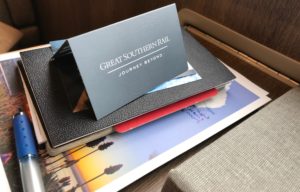
Day One
Leaving the Station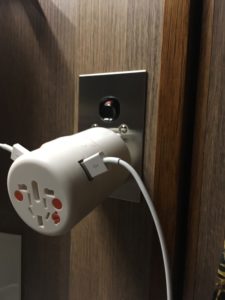
We left Perth at 7:30 a.m. I sat in my cabin, as requested by our Hospitality Attendant, who had greeted us at the door and led us to our cabins. Examining the various brochures and other reading material that had been provided, I learned a few things I hadn’t known about Perth. For example, it is the westernmost capitol city in Australia, 2313 miles by road from the national capitol territory of Canberra, and it has nearly two million residents. Perth averages 3000 hours of sunshine a year, and advertises that it has 19 “stunning” beaches along a ten mile stretch between Scarborough and Cottlesloe. I had yet to see Noosa Beach in Queensland, but for the time being I thought Cott was the prettiest beach I’d ever seen. We have many beaches in Santa Cruz and down the coast to Monterey, but they are more rocky and usually strewn with seaweed and miscellany. I may be more motivated to attend our next beach cleanup day after seeing those lovely sandy stretches.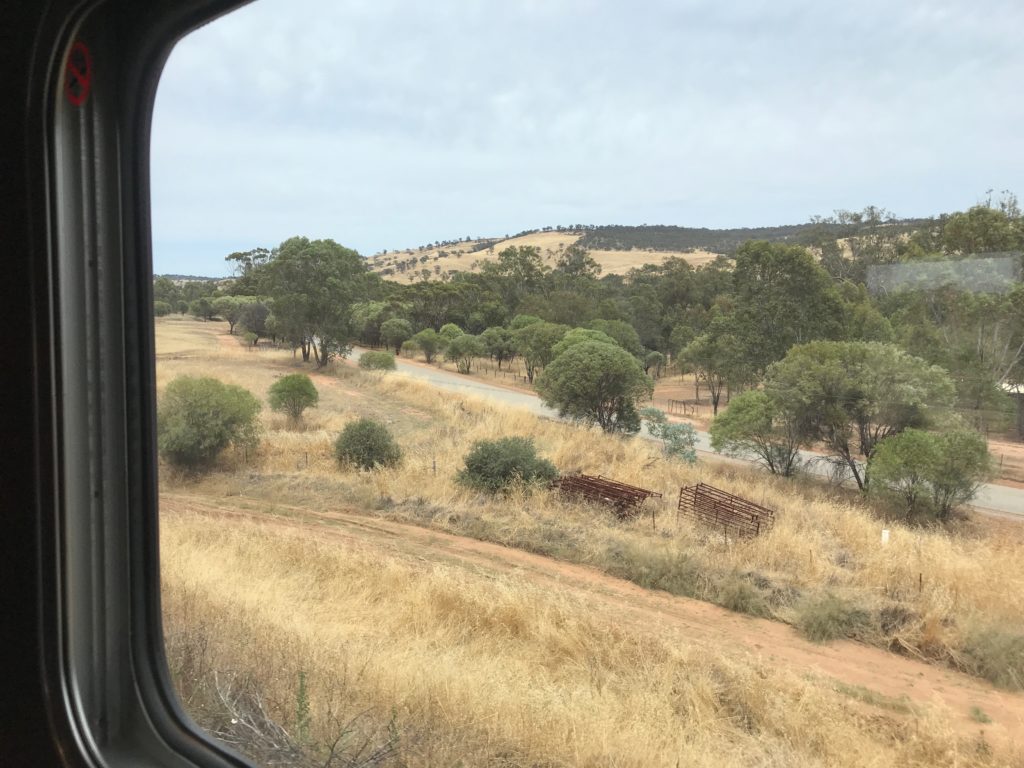
Avon Valley
About an hour out of Perth, we began traveling through the Avon Valley, which my tour book described as “nestled in the Western Australian wheat belt.” The scene outside my cabin window reminded me of California. We followed the Avon River for much of the morning, shaded by gum trees and with a backdrop of cut brown grass. Pretty, but not exactly how I had pictured the Outback.
I had begun settling in to my cabin. It had two comfortable seats, facing one another, with a fold-down table and a window between them. In one corner was a narrow cabinet with hooks to hang clothes, and in the other a very compact but serviceable sink and mirror. Under the sink was another cabinet in which to store things. By the time our Train Manager arrived, I had unpacked my knapsack and stashed toiletries and clothes away. Deb Munn introduced herself and asked if I had any questions; since I had heard her describing the location of restrooms and showers, the parlor car and the dining room to other passengers, I said no. She located my meal schedule card from the stack of material on my table and helped me fill in my preferred times as they were available. I signed up for the 9:00 breakfast shift, so when she moved on I began heading for the dining room, along with others from the same car. On the way, we passed through four other sleeping cars, some with double bedded cabins, others with twins, several with en suite bathrooms. At the end of our car, just past a restroom and two showers, was a 24-hour coffee and tea bar; I took note of that for the next morning. I like my coffee as soon as I wake up.
The Parlour Car
Each dining table seated four people. The three other women and I who ate together that first morning got along well, and we for the rest of our journey we usually ate or explored together. One of our group was from Sweden and one from Japan. Our fourth companion lives in Adelaide. She had just taken the train to Perth and was looking forward to the return trip. Being our resident “expert,” she pointed out some of the other features of our rolling hotel when we returned to our rooms later, including our Train Manager’s office, which was filled with colorful balloons to celebrate her 33rd anniversary working for Indian Pacific.
Our breakfast choices were healthy and tasty; that’s all I remember because we were so busy talking to one another. After breakfast we sat in the adjacent parlour car, which was essentially a traveling lounge, with comfortable chairs, some of which swiveled to optimize your view or your ability to face fellow passengers. We were of all ages, perhaps more with grey hair than other colors, but the conversations involved young and old and a wide variety of topics. Coffee, tea, wine, beer, and spirits were available from the bar, and throughout the day baskets of fresh fruit, nuts, and crackers and cheese appeared on the cocktail-sized tables. After an hour or so we returned to our rooms and I fiddled with my technology. I plugged my charger into an outlet over the sink so I could charge my iPad and iPhone, which I was using primarily as a camera. While they charged I wrote postcards and read about Kalgoorlie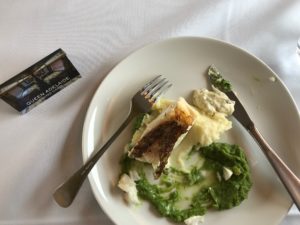 , where we would be stopping late that night. Soon it was time to walk back through through the four carriages to the parlour car and enjoy a glass of wine before lunch: Cod with creamy mashed potatoes and mushy peas, with a fruit plate for dessert. Oh yes, and another glass of wine, this one a Clare Valley Riesling. What a life.
, where we would be stopping late that night. Soon it was time to walk back through through the four carriages to the parlour car and enjoy a glass of wine before lunch: Cod with creamy mashed potatoes and mushy peas, with a fruit plate for dessert. Oh yes, and another glass of wine, this one a Clare Valley Riesling. What a life.
I could see from our schedule that this day would be a long one, so after lunch I stretched out with my feet on one bench and the rest of my body on the other and took a nap. Before dinner I tried out the hot spot that Mark had set up on his Australian smartphone, and discovered that I could use it to provide connectivity to my iPad . The connection was sufficient for me to read my online students’ papers and grade them. There were still three more weeks left in the fall semester, so that was good news. I spent the rest of the afternoon alternately looking out the window and grading student papers. Not too surprisingly, I fell asleep again and awakened only when I heard my neighbors opening their sliding doors and heading for dinner. From the dining room I saw that the scenery had changed.
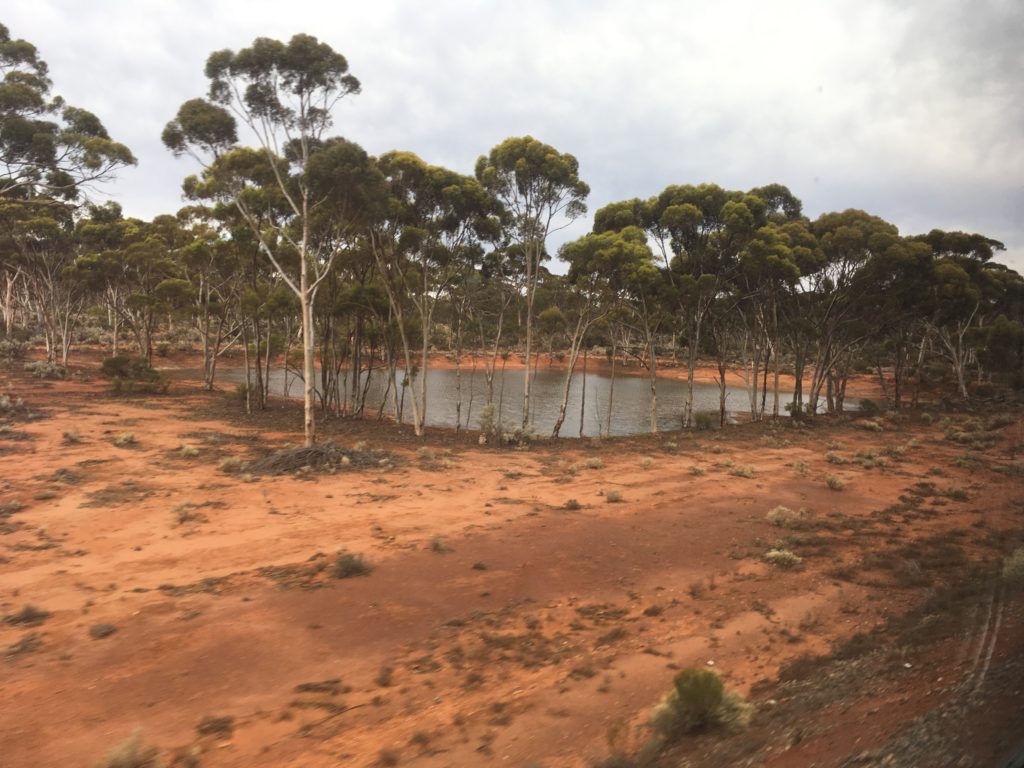 The red soil of central Australia is iconic. Among other things, it has been exploited by journalists and considered by scientists as a potential Mars double. According to Joanne C Wittstock, a minerals and petroleum geologist, red rock and soil stains are common in arid environments like South and Central Australia. They are typically iron oxides, commonly known as rust, and they result from atmospheric oxygen and what little moisture there is oxidizing the iron sulphides in bedrock. Very little water washes the surface, so the iron oxides are not washed away. The result is red sand, soil and stains on outcrops. Some of our fellow passengers called the soil pindan red.
The red soil of central Australia is iconic. Among other things, it has been exploited by journalists and considered by scientists as a potential Mars double. According to Joanne C Wittstock, a minerals and petroleum geologist, red rock and soil stains are common in arid environments like South and Central Australia. They are typically iron oxides, commonly known as rust, and they result from atmospheric oxygen and what little moisture there is oxidizing the iron sulphides in bedrock. Very little water washes the surface, so the iron oxides are not washed away. The result is red sand, soil and stains on outcrops. Some of our fellow passengers called the soil pindan red.
Of course I had to Google the word, and I learned that pindan is actually the name given to the red-soil country of the south-western Kimberley region of Western Australia, many miles north of our route. The term comes from a local language and originally applied both to the soil and to the vegetation community associated with it. Even with the difference in vegetation, I suppose pindan could apply to the red soil in the Kalgoorlie region also, in a colloquial fashion. I didn’t care what it was called; I just enjoyed looking at the color and the changing vegetation as we traveled closer to the gold fields. This is much more how I imagined the interior of Western Australia would look.
Kalgoorlie-Boulder
Our visit to the historic town and Super Pit gold mine in Kalgoorlie began at 10:00 p.m., so was a bit surreal. As we poured out of our railway cars, we were greeted by a line of full sized tour buses, the driver and a guide standing beside each one. The large vehicles stretched into the darkness and I never did see all of them at once, but I think there must have been five or six. Once seated and safety-belted (Australia has strict safety belt laws, even for tour buses) we had a birds-eye view of the mining town, now asleep, and our guide identified various places of interest as we passed them – the school, recreation center, library, town hall, grocery store, etc.
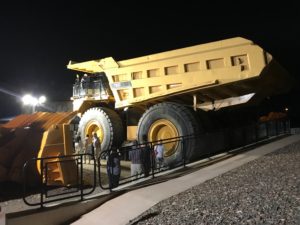
We took turns climbing on the trucks and bulldozers in order to get a sense of their great size.
As we headed out of town toward the Super Pit, the guide then explained the gold mining history and some of the important characteristics of the community. Such as, for example, FIFO (Fly In, Fly Out) employees are not allowed at this mine, even though such shifts are popular at many other mines in Australia. “If you want to work here,” our guide said fiercely, “you have to live here.” That, he believes, is the most significant characteristic that makes this community work — everyone who works here is committed to making the town a good place to live.
When we climb down from our high seats on the bus, we are at the Western Australian Museum, where a short play depicting the discovery of gold in the Kalgoorlie region was performed by two local actors. We were given some time to examine the museum displays, which included a boardroom and office, miner’s cottage and a police wagon, all furnished in 1850s style and a collection of objects used in the goldfields in the early 20th century. Due to the late hour we couldn’t see the gold nuggets or jewelry in the underground vault or go up in the lift (elevator) and see the surrounding countryside, but we saw enough to get a sense of the isolation of the community and of its history. You can also drive to Kalgoorlie-Boulder (The Shire of Boulder and Town of Kalgoorlie amalgamated in 1989 to form the City of Kalgoorlie-Boulder) for economic reasons but people still talk about the two towns as if they are separate) Accommodation and eating establishments are available; tourism is an important part of the local economy.
We were next taken to the Super Pit, which was Super Surreal in the darkness.
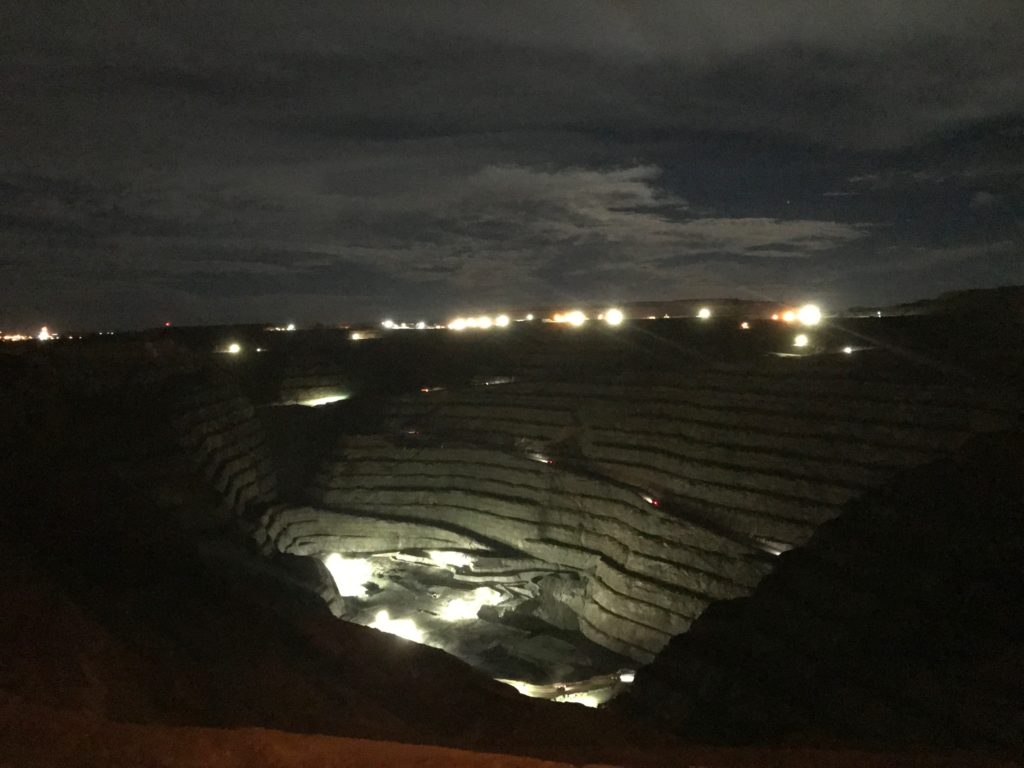
The Kalgoorlie Super Pit was Australia’s largest open cut gold mine until 2016 when it was surpassed by the Newmont Boddington gold mine, also in Western Australia. The Super Pit is oblong in shape and is approximately 2 1/4 miles long, 1 mile wide and 1679 feet (1/3 mile) deep. At these dimensions, you can see it from space.
The Super Pit is owned by Kalgoorlie Consolidated Gold Mines Pty Ltd, produces 850,000 ounces (28 tons) of gold per year, and employs around 1000 employees directly on site. Since 1989, the Super Pit has produced over 13 million ounces of gold.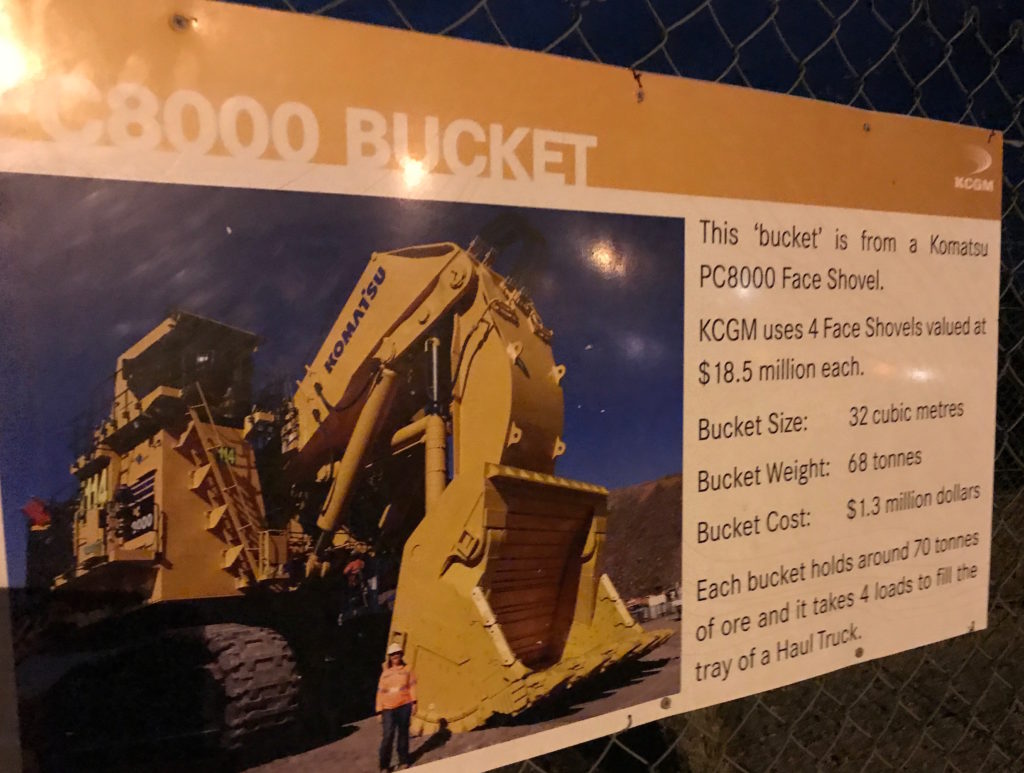
Eventually we were led to the gift shop, given a glass of port and an invitation to go shopping. We hovered around in the half light of the gift shop, still drawn to the Super Pit and the monster vehicles working their way down to the bottom, where they looked like insects on a pile of sand. When we returned to our train, our tables had been folded down, our beds made up, and our Hospitality Attendant was there to meet our every need. Bed was all I needed. I closed the door of my cabin but pulled the curtains away from the windows. The sound of the wheels clicking on the track made me quietly chant I think I can I think I can I think I can. The moon was nearly full, so I fell asleep to gum trees passing by in a blur, eerily lit by the gibbous moon.
Episode 4 will complete my railway adventure and get me to a hostel in Adelaide. Check back next week for that post. Better yet, subscribe by entering your email address in the form at the right and you will get the post in your email when it is published. See you next week!
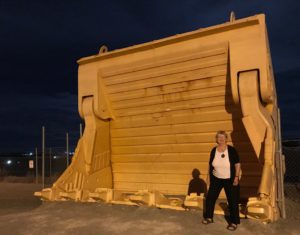
I’m standing in front of the claw of the shovel, the part at the bottom of the bucket in the big picture.
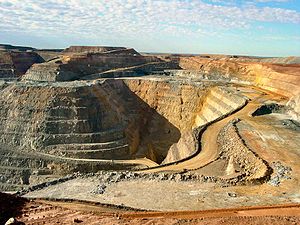
The pit in daylight looks even larger
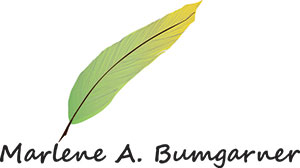

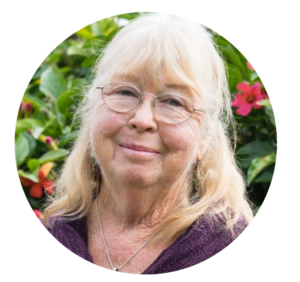
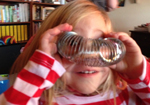

What an amazing life story Marlene, and how great to celebrate this special birthday on this way.
Lieve,
It was certainly a lot of fun! Marlene
Your trip looks very exciting. But now I am wondering, are you Australian, visiting this enormous large country of yours, or do you live somewhere else? Sorry for my curiosity, but ‘why not asking’ I was thinking.
Lieve,
That is a perfectly reasonable question. I was actually born in England, and currently live in California. My parents and I immigrated to the U.S. in 1949 and about the same time two of my fathers’ sisters and their families emigrated to Australia, followed later by my grandparents. That led to us moving there in 1953. I started school there, and waved at Prince Phillip when he passed through Melbourne during the Royal Tour of 1954. We returned to the US after two years, but immigrated to Australia again (I know, it’s kind of crazy) in 1961. Long story, but we ended up back in the U.S. so I could finish high school with my friends. Last spring, approaching 70, I was looking for something to do to mark this milestone birthday. When a wedding invitation arrived from my cousin’s son, I realized that I could attend his wedding and also visit cousins and old friends. I’d always wanted to take the luxury train across the center of the country, and so I started by reserving a cabin on that. Next I lay a map of Australia on my table and marked the location of Evan’s wedding and each of my friends’ and relatives’ homes. After that I began researching bus, train, and plane schedules and booking rooms.
Marlene